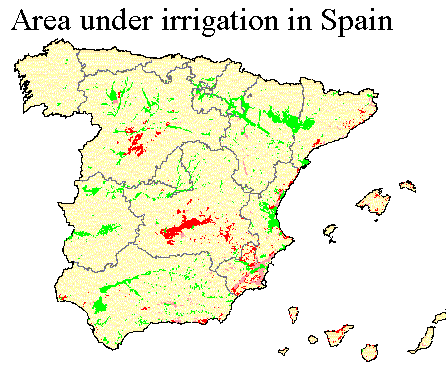|
|
 |
|
|
|
 |
| |
|
|
 |
Food & Climate
Read more |
Case studies in developed countries
Spain
Agriculture in Spain is both the main use of the land in terms of area (over 50% of total land area) and the principal water-consuming sector of the economy (over 60% of total water consumption).
|
|
|
|
|
 |
 |
 |
|
1. Irrigated land in Spain. Source. Plan Nacional de Regadíos. In the picture you can see the total surface area used for irrigated agriculture in Spain. The green spots are those areas irrigated with surface water, the red ones are the areas irrigated with groundwater resources and the pink ones are those that use a mixture of both resources.
Please click to enlarge!
|
|
 |
Agriculture in Spain is more sensitive to interannual variations in weather than many other European regions. This is because the physical factors affecting production in Spain (soils, terrain, and climate) are generally less suited to farming than in other countries. Crop production in Spain varies by up to 20 percent from year to year, largely as a result of the highly variable weather conditions.
There is now concern that changes in climate resulting from anthropogenic emissions of greenhouse gases may have negative effects on crop production in Spain. The aim of this case study is to look at the potential impacts of different climate change scenarios on Spanish crop production at both the national and regional level.
|
|
Problem: Spain is undergoing rapid changes in the structure of its agricultural sector and increased demands on land and water resources have exacerbated pressures on the environment. Projecting the impact of climate change on national agriculture should help to prepare the sector for the future. The aim of this case study is to examine the regional competitive advantage of dry land agricultural production in Spain in order to project future land use.
Methods: Crop models integrated with Decision Support Systems are be used to evaluate crop productivity and test the relative economic advantages of different agricultural management options.
|
Scenarios: Climate change scenarios for 2050 were developed using the U.K. Hadley Centre Global Circulation Model (GCM) . In the GCM, simulations of future climate are conducted where greenhouse gas forcing is gradually increased over time (1% increase per year increase, compounded, in equivalent CO2).
|
 |
 |
 |
|
2. Results of the model. These four maps are the results of models of climate change and show how climate change would affect both irrigated and non irrigated agriculture in Spain.
Please click to enlarge!
|
|
|
The scenario which just consideres predicted rises in greenhouse gases is designated GG. A second simulation which includes the effects of greenhouse gases and sulphate aerosols is designated GS. Sulphate aerosols tend to reflect and scatter solar radiation back into space and thus introduce a cooling factor into the GCM simulations.
Results: Despite the uncertainties associated with the use of GCM's it is clear that, even in the best case scenario (GS), agricultural production is likely to decline in the central regions of Spain which are currently the most productive regions of the country. Considering the current high production costs and the variability in the water available for irrigation, crop growth may have to be abandoned in some areas, particularly these central regions, unless major changes in crop management are implemented.
|
About this page:
Author: Marta Moneo and Dr. Ana Iglesias - Universidad Politécnica de Madrid, España
1. scientific reviewer: Alex de Sherbinin - CIESIN, Columbia University, USA
2. scientific reviewer: Lily Parshall - Goddard Institute for Space Studies, Columbia University, USA
educational reviewer: Emilio Sternfeld - Colegio Virgen de Mirasierra - España
last published: 2004-05-12
|
|
 |
|







